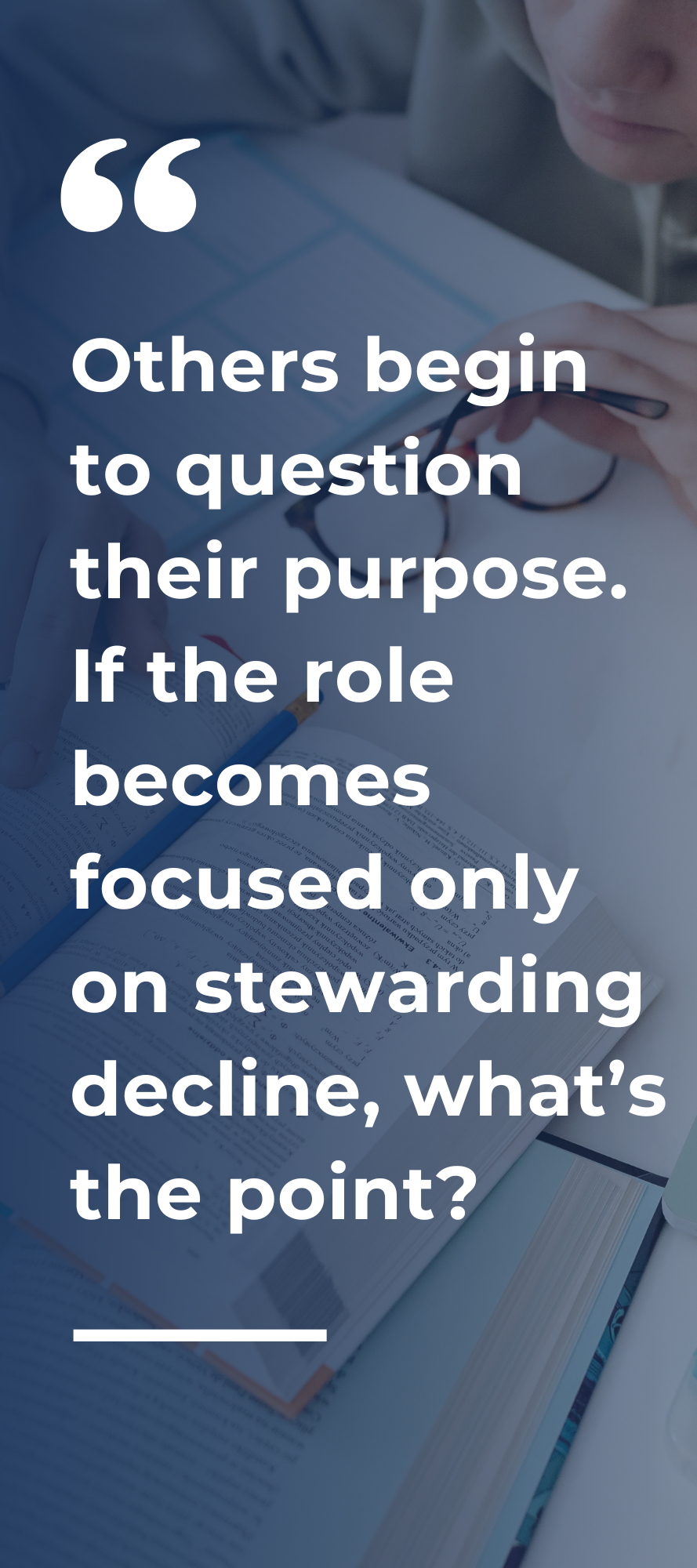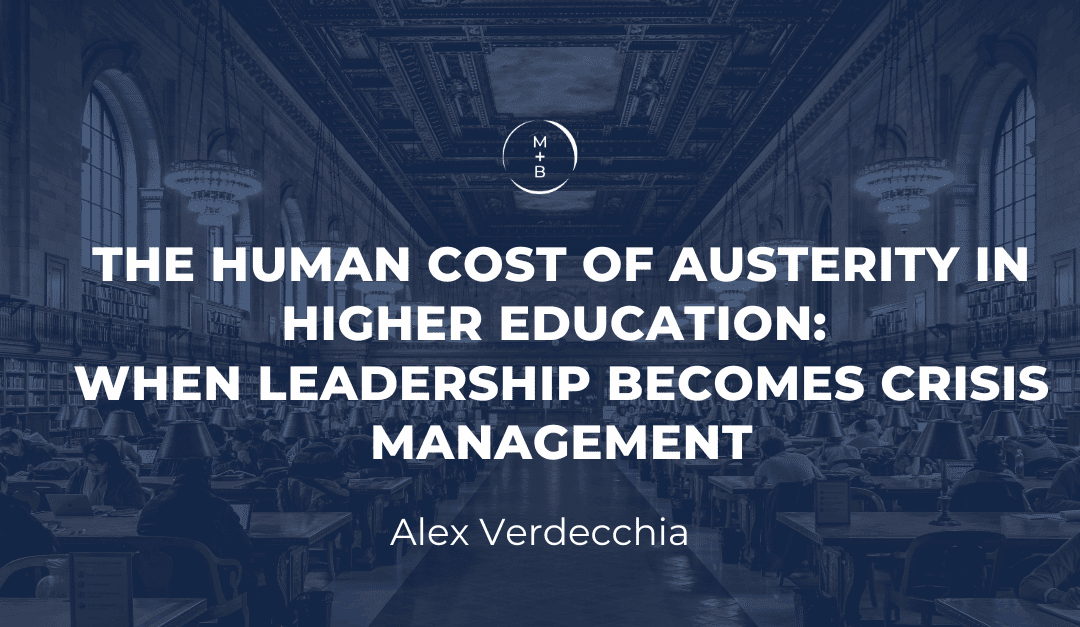The University Paradox
“Universities aren’t businesses.”
I paused. I’ve had this conversation before. “But they still have to balance budgets, pay employees, and keep the lights on. They can’t ignore financial reality.”
“Sure, but a business exists to make money. A university exists to create knowledge, educate students, and serve the public good. Those are different goals.”
She’s correct, of course. But when funding gets tight and austerity measures kick in, academic leaders are left making decisions that feel eerily similar to the ones corporate executives face during crises: What do we cut? Who do we lay off? What can we sacrifice without losing everything?
Unlike corporations, universities can’t simply pivot, scale, or chase profit to stay afloat. Their job is to do more with less, forcing them into impossible trade-offs.
The Personal Toll on Academic Leadership
At first glance, post-secondary education leaders might seem like the ones least affected by austerity. After all, they’re the ones sitting at the head of the table when budgets get slashed. But what’s often overlooked is the profound personal toll these decisions exact.
Imagine spending your entire career advocating for the value of education, only to be the one forced to decide which programs to cut. Imagine having to tell brilliant faculty members, colleagues, mentors, even friends, that their positions are being eliminated, not because of performance, but because the numbers don’t add up.
For many academic leaders, austerity doesn’t just mean managing financial shortfalls; it means dismantling the very things that brought them into higher education leadership in the first place and knowing every cut makes it harder for the institution to fulfill its mission.
Over time, these measures wear leaders down. Some leave the profession early, burnt out from the relentless cycle of crisis management. Others begin to question their purpose. If the role becomes focused only on stewarding decline, what’s the point? [1]

The Institutional Impact: When Leadership Instability Becomes Everyone’s Problem
When academic leaders burn out or step down early, the consequences ripple far beyond their offices. Leadership instability, combined with perpetual budget cuts, creates a cascading effect that impacts staff, faculty, and students. [2]
Faculty Experience
For faculty, austerity erodes morale and breeds resentment. When cuts come down, administrators often take the blame. To many faculty members, administrators begin to resemble corporate executives, making cold financial decisions at the expense of teaching and research.
There’s often a deep frustration that administrators, many of whom no longer teach, are out of touch with the realities of the classroom. It doesn’t help that some of the toughest decisions, like program closures and layoffs, can feel unilateral, leaving faculty feeling powerless and unheard.
Student Impact
For students, the cost goes beyond tuition hikes. Budget cuts often lead to larger class sizes, fewer course offerings, and reduced student services. Meanwhile, instability caused by austerity (fewer full-time professors) means students have less access to mentorship and academic support. [3]

Institution Reputation
For the broader academic community, institutional reputation is at stake. When leadership turns over frequently, programs are cut, and faculty or students feel unsupported, an institution’s credibility erodes. Donors hesitate to invest in organizations that seem unstable. [4] Top faculty and promising students take their talents elsewhere.
Over time, these challenges extend beyond a single campus, contributing to a broader erosion of public trust in the higher education sector.
Leadership Crisis: Nobody Signs Up to Dismantle Their Institution
But here’s the truth that often gets lost: No leader I’ve spoken with entered academic leadership to dismantle the institutions they care about. These decisions are never taken lightly. When cuts are made, they are accompanied by the same sense of grief, loss, frustration, and helplessness felt by those most directly affected.
Yet under the weight of prolonged austerity, the space for long-term vision begins to narrow. Leadership shifts from building the future to simply managing decline. For many, it’s that quiet erosion of purpose amplified by constant criticism that ultimately drives them away.
And increasingly, they are walking away.
In Canada, the average tenure of university presidents has declined significantly over the past several decades:
- 1950s: ~8 years average tenure
- 2010s: ~4 years average tenure
- 2006-2010: 12 presidents left within three years (compared to just 4 in the previous five years) [5]
It’s a pattern that speaks to more than just turnover; it reflects the emotional and professional exhaustion of leading through prolonged austerity. Today’s presidents are not only expected to manage shrinking budgets but to do so while maintaining morale, protecting institutional identity, and absorbing criticism from all sides. As one study of Canadian university leadership notes, the weight of these demands is compounded by unclear support from governing boards and a lack of mechanisms to meaningfully evaluate or sustain presidential leadership. [6]
This isn’t simply about evolving roles; it’s about impossible expectations in an environment of declining resources. And it’s not just presidents who are affected.
Behind the headlines are quieter departures: vice presidents, deans, and department heads who step away, worn down by roles that no longer align with their values. One former dean of a mid-sized Canadian college, who asked to remain anonymous, put it bluntly:
“I didn’t take this job to be a layoff manager. I spent years fighting for my faculty, but at some point, I felt like I was just managing decline, and this wasn’t the mandate I was hired to fulfill. The job became unrecognizable.”
These aren’t stories of failed leadership; they’re evidence of an impossible system. Leaders are expected to balance budgets without betraying the university’s mission, make painful cuts without alienating faculty, and absorb pressure from all sides without faltering. Over time, even the most committed begin to walk away because the role no longer fits.
What Needs to Change: Beyond the Budget, Rethinking Institutional Resilience
The recent changes to international student permits imposed by the Canadian government have exposed our sector’s overreliance on international tuition to fill gaps left by stagnant public funding. As this revenue stream narrows, the urgency to diversify funding sources and reassess institutional priorities becomes undeniable.
Yet the solutions can’t rest on numbers alone. Each institution is already navigating this terrain with its own unique constraints. If we hope to navigate the emotional and organizational toll of austerity, our most meaningful progress may lie not just in how we balance the books, but in how we lead, communicate, and connect through the process.
Framework for Institutional Resilience
1. Enhancing Transparency and Stakeholder Engagement
In an environment shaped by financial volatility and institutional strain, the strength of internal relationships remains critical, but so too does clarity about roles and responsibilities. Financial decisions ultimately rest with those charged with institutional stewardship. While broader consultation can enrich understanding, opening every decision to committee debate risks delaying urgent action and deepening frustration when expectations go unmet.
In this context, transparent, consistent communication is essential. A well-known communications maxim reminds us: when you’re tired of saying it, people are just starting to hear it. In marketing, the “Rule of Seven” holds that a message must be heard multiple times, often seven or more, before it begins to resonate. [7]
Amid the sustained financial pressures facing higher education, repetition, clarity, and empathy become strategic tools. It’s not only what decisions are made, but how relentlessly and thoughtfully they are explained that may determine whether a community holds together or begins to fracture.
2. Sustaining Leadership Through Crisis and Complexity
Today’s financial realities are asking more of institutional leaders than ever before, not only in terms of technical decision-making but in their capacity to manage uncertainty, lead with empathy, and sustain the morale of their communities. As the pressures mount, so too does the potential for leadership fatigue, particularly when the burden of institutional stability rests on too few shoulders.
Leadership in this context can no longer follow a heroic model, where responsibility is concentrated, and burnout is normalized. Instead, what is needed now is a shift toward intentional, human-centered leadership practices that sustain both individuals and institutions, practices that:
- Reinforce leadership teams rather than isolating decision-makers
- Value diverse input while maintaining clear decision authority
- Equip leaders with the tools they need to navigate strategically through complexity
- Create space for renewal and reflection amid ongoing crises
3. Empathy as a Shared Responsibility
The challenges facing post-secondary institutions today are not just technical or financial; they are profoundly human. As leaders navigate hard choices and shrinking resources, the true test lies not only in what they decide but in how those decisions are carried out and communicated.
Empathy must become a central leadership competency. It is what enables honesty without alienation, transparency without fear, and unity in the face of institutional strain.
But empathy cannot flow in only one direction. Just as it is vital that senior administrators lead with empathy, it is equally important that faculty, staff, and students extend empathy upward and laterally to peers and to leaders working under extraordinary constraints. Understanding, patience, and the willingness to see complexity on all sides are essential to holding institutions together during periods of austerity.
Preserving Our Purpose Through Financial Constraints
Financial constraints may define the moment, but they do not have to define our relationships. Empathy, clarity, and deep listening might not change the numbers, but they can change how we weather them and who we remain in the process.
As we navigate this challenging terrain, let’s remember that post-secondary institutions were meant to endure. Their resilience has historically come from their shared commitment to knowledge, learning, and societal impact. By fostering leadership approaches that balance financial reality with institutional purpose, we can preserve not just our institutions, but the reasons we built them in the first place.
About the Author
Alex Verdecchia, Principal
Alex serves as a Principal at McDermott + Bull Canada and is part of the firm’s Education Practice, based in Vancouver, BC. With over 20 years of experience in executive search, Alex is known for his successful collaborations with clients, sourcing top-tier talent across diverse industries and functions. His core areas of focus include post-secondary education, NPOs, healthcare, professional colleges, associations, and municipalities.
References
- Inside Higher Ed. “Turnover, Burnout and Demoralization in Higher Ed.” May 4, 2022. https://www.insidehighered.com/news/2022/05/04/turnover-burnout-and-demoralization-higher-ed.
- Inside Higher Ed. “Turnover, Burnout and Demoralization in Higher Ed.” May 4, 2022. https://www.insidehighered.com/news/2022/05/04/turnover-burnout-and-demoralization-higher-ed.
- Elcid Online. “The Hidden Cost of Budget Cuts: How Reduced University Funding Impacts Students.” March 4, 2025. https://elcidonline.com/world-news/2025/03/04/the-hidden-cost-of-budget-cuts-how-reduced-university-funding-impacts-students/.
- Dickerson Bakker. Why Are Universities Losing Donors? Donor Retention Tips for Higher Ed.” June 26, 2024 https://blog.dickersonbakker.com/why-are-universities-losing-donors.
- University Affairs. “University presidents spend fewer years at the top, on average, new research shows.” Accessed April 2025. https://archives.universityaffairs.ca/news/news-article/university-presidents-spend-fewer-years-at-the-top-on-average-new-research-shows/.
- University Affairs. “University presidents spend fewer years at the top, on average, new research shows.” Accessed April 2025. https://archives.universityaffairs.ca/news/news-article/university-presidents-spend-fewer-years-at-the-top-on-average-new-research-shows/.
- Forbes. “Why Marketers Should Follow The Rule Of Seven.” September 21, 2023. https://www.forbes.com/councils/forbescommunicationscouncil/2023/09/21/why-marketers-should-follow-the-rule-of-seven/.


